SDR-Based Portable System for Evaluating Exposure to Ambient Electromagnetic Fields
Abstract
:1. Introduction
2. Materials and Methods
2.1. RF-EMF Measurement Unit Design
2.1.1. Fixed Channel Measurement
- Upper and lower cut-off frequencies, defined so that the DC component is rejected; therefore, fcutoff_1 = 50 Hz and fcutoff_2 = sample_rate/2;
- The use of a rectangular window, ensuring uniform attenuation of all frequencies beyond the region of interest, without introducing additional attenuation to frequencies close to the cut-off frequency;
- Employing a narrow transition width of 10 kHz, in order to facilitate rapid transitions between the passband zone and the rejection zone.
- The complex signal is subjected to conjugation;
- The two sequences of values (the complex one and the conjugated one) are then multiplied, resulting in a real sequence of values that correspond to the magnitudes of the complex numbers, signifying the power density level;
- The average power within the designated frequency band is calculated by feeding the real signal into a sliding averaging block (MovingAverage), having as output the sum of the last N = 50000 samples, and divided by N;
- Subsequently, the computed average power is transformed into a logarithmic scale, resulting in a value expressed in decibels (dB). The Log10 block performs the following operation: output = n * log10 (input) + k, with the scalar multiplicative constant n = 10, and the scalar additive constant k being set to 0.
2.1.2. Frequency Sweep Measurement
2.2. Measurement Data Processing Design
- A server that receives data from GNU Radio;
- A connection to the serial port for receiving data from the GPS module;
- A connection to the “hackrf” database where information pertaining to power, frequency, and the system’s geographical coordinates are recorded.
- If the GPS module does not receive any position-related data, identified by a message of type $GNGGA, the application proceeds to insert the position data for the city of Bucharest (44 degrees, 43 min north latitude; 26 degrees, 9 min east longitude) into the database. Simultaneously, it includes the nominal signal strength values received by the HackRF receiver;
- Conversely, if the GPS module successfully establishes a connection with the satellites, enabling it to determine the system’s precise position, the application records the actual positional data at the moment of program execution using the “insertPower(mydb, power [0], latitude, longitude, type)” command. Here, the “type” variable holds real-value data.
3. System Testing Results
3.1. Comparative Testing of Two RF-EMF Measurement Unit Versions
- A Wi-Fi router with a transmitting whip antenna (Tx), connected to the Internet through an Ethernet cable;
- The two configurations of the RF measurement unit, each consisting of a receiving (Rx) patch antenna and a HackRF device connected to a laptop; the HackRF device has an operating frequency ranging from 1 MHz to 6 GHz, with a bandwidth of 20 MHz, and the laptop runs with a 2.8 GHz Intel Core i7 CPU;
- A reference measurement device represented by a spectrum analyzer (SA)—Aaronia Spectran 6080-V4, which operates in the 10 MHz–8 GHz band, and a receiving log-periodic directional antenna Aaronia HyperLog 7025, with a 5 dB gain. The spectrum analyzer is connected to a laptop with dedicated software (Aaronia MCS Spectrum Analyzer Software 2.1.6.
3.2. Portable System Testing
4. Discussion
- The receiver was linked to the router without soliciting data from the Internet network;
- The receiver, via the router, accessed web pages featuring substantial data content.
5. Conclusions
Author Contributions
Funding
Data Availability Statement
Conflicts of Interest
References
- Chou, C.-K. Controversy in Electromagnetic Safety. Int. J. Environ. Res. Public Health 2022, 19, 16942. [Google Scholar] [CrossRef]
- Bartosova, K.; Neruda, M.; Vojtech, L. Methodology of Studying Effects of Mobile Phone Radiation on Organisms: Technical Aspects. Int. J. Environ. Res. Public Health 2021, 18, 12642. [Google Scholar] [CrossRef]
- Sârbu, A.; Miclău, S.; Digulescu, A.; Bechet, P. Comparative Analysis of User Exposure to the Electromagnetic Radiation Emitted by the Fourth and Fifth Generations of Wi-Fi Communication Devices. Int. J. Environ. Res. Public Health 2020, 17, 8837. [Google Scholar] [CrossRef]
- Redmayne, M.; Maisch, D. ICNIRP Guidelines’ Exposure Assessment Method for 5G Millimetre Wave Radiation May Trigger Adverse Effects. Int. J. Environ. Res. Public Health 2023, 20, 5267. [Google Scholar] [CrossRef]
- Vijayalaxmi. Biological and health effects of radiofrequency fields: Good study design and quality publications. Mutat. Res. Genet. Toxicol. Environ. Mutagen. 2016, 810, 6–12. [Google Scholar] [CrossRef]
- Panagopoulos, D.J.; Johansson, O.; Carlo, G.L. Real versus Simulated Mobile Phone Exposures in Experimental Studies. BioMed Res. Int. 2015, 2015, 607053. [Google Scholar] [CrossRef]
- Tsatsakis, A.M.; Kouretas, D.; Tzatzarakis, M.N.; Stivaktakis, P.; Tsarouhas, K.; Golokhvast, K.S.; Rakitskii, V.N.; Tutelyan, V.A.; Hernandez, A.F.; Rezaee, R.; et al. Simulating real-life exposures to uncover possible risks to human health: A proposed consensus for a novel methodological approach. Hum. Exp. Toxicol. 2017, 36, 554–564. [Google Scholar] [CrossRef] [PubMed]
- Tognola, G.; Plets, D.; Chiaramello, E.; Gallucci, S.; Bonato, M.; Fiocchi, S.; Parazzini, M.; Martens, L.; Joseph, W.; Ravazzani, P. Use of Machine Learning for the Estimation of Down- and Up-Link Field Exposure in Multi-Source Indoor WiFi Scenarios. Bioelectromagnetics 2021, 42, 550–561. [Google Scholar] [CrossRef] [PubMed]
- Spandole-Dinu, S.; Catrina, A.-M.; Voinea, O.; Andone, A.; Radu, S.; Haidoiu, C.; Călborean, O.; Popescu, D.; Suhăianu, V.; Baltag, O.; et al. Pilot Study of the Long-Term Effects of Radiofrequency Electromagnetic Radiation Exposure on the Mouse Brain. Int. J. Environ. Res. Public Health 2023, 20, 3025. [Google Scholar] [CrossRef] [PubMed]
- Kostoff, R.N.; Heroux, P.; Aschner, M.; Tsatsakis, A. Adverse health effects of 5G mobile networking technology under real-life conditions. Toxicol. Lett. 2020, 323, 35–40. [Google Scholar] [CrossRef] [PubMed]
- Urbinello, D.; Joseph, W.; Verloock, L.; Martens, L.; Röösli, M. Temporal trends of radio-frequency electromagnetic field (RF-EMF) exposure in everyday environments across European cities. Environ. Res. 2014, 134, 134–142. [Google Scholar] [CrossRef] [PubMed]
- Atanasova, G.; Atanasov, B.; Atanasov, N. Assessment of Electromagnetic Field Exposure on European Roads: A Comprehensive In Situ Measurement Campaign. Sensors 2023, 23, 6050. [Google Scholar] [CrossRef]
- Mallik, M.; Tesfay, A.; Allaert, B.; Kassi, R.; Egea-Lopez, E.; Molina-Garcia-Pardo, J.-M.; Wiart, J.; Gaillot, D.; Clavier, L. Towards Outdoor Electromagnetic Field Exposure Mapping Generation Using Conditional GANs. Sensors 2022, 22, 9643. [Google Scholar] [CrossRef] [PubMed]
- Petroulakis, N.; Mattsson, M.-O.; Chatziadam, P.; Simko, M.; Gavrielides, A.; Yiorkas, A.; Zeni, O.; Scarfi, M.; Soudah, E.; Otin, R.; et al. NextGEM: Next-Generation Integrated Sensing and Analytical System for Monitoring and Assessing Radiofrequency Electromagnetic Field Exposure and Health. Int. J. Environ. Res. Public Health 2023, 20, 6085. [Google Scholar] [CrossRef] [PubMed]
- Onishi, T.; Esaki, K.; Tobita, K.; Ikuyo, M.; Taki, M.; Watanabe, S. Large-Area Monitoring of Radiofrequency Electromagnetic Field Exposure Levels from Mobile Phone Base Stations and Broadcast Transmission Towers by Car-Mounted Measurements around Tokyo. Electronics 2023, 12, 1835. [Google Scholar] [CrossRef]
- Mulugeta, B.; Wang, S.; Chikha, W.B.; Liu, J.; Roblin, C.; Wiart, J. Statistical Characterization and Modeling of Indoor RF-EMF Down-Link Exposure. Sensors 2023, 23, 3583. [Google Scholar] [CrossRef]
- Bonato, M.; Dossi, L.; Chiaramello, E.; Fiocchi, S.; Tognola, G.; Parazzini, M. Stochastic Dosimetry Assessment of the Human RF-EMF Exposure to 3D Beamforming Antennas in indoor 5G Networks. Appl. Sci. 2021, 11, 1751. [Google Scholar] [CrossRef]
- Deprez, K.; Colussi, L.; Korkmaz, E.; Aerts, S.; Land, D.; Littel, S.; Verloock, L.; Plets, D.; Joseph, W.; Bolte, J. Comparison of Low-Cost 5G Electromagnetic Field Sensors. Sensors 2023, 23, 3312. [Google Scholar] [CrossRef]
- Van Torre, P.; Agneessens, S.; Aminzadeh, R.; Thielens, A.; Bossche MV, D.; Joseph, W.; Rogier, H. Wearable multi-antenna multi-band measurement system for personal radio-frequency exposure assessment. In Proceedings of the European Medical and Biological Engineering Conference, Singapore, 13 June 2017; pp. 687–690. [Google Scholar]
- Urbinello, D.; Huss, A.; Beekhuizen, J.; Vermeulen, R. Use of portable exposure meters for comparing mobile phone base station radiation in different types of areas in the cities of Basel and Amsterdam. Sci. Total Environ. 2014, 468–469, 1028–1033. [Google Scholar] [CrossRef]
- Aminzadeh, R.; Thielens, A.; Gaillot, D.P.; Lienard, M.; Kone, L.; Agneessens, S.; Van Torre, P.; Van den Bossche, M.; Verloock, L.; Dongus, S.; et al. A Multi-Band Body-Worn Distributed Exposure Meter for Personal Radio-Frequency Dosimetry in Diffuse Indoor Environments. IEEE Sens. J. 2019, 19, 6927–6937. [Google Scholar] [CrossRef]
- Celaya-Echarri, M.; Azpilicueta, L.; Karpowicz, J.; Ramos, V.; Lopez-Iturri, P.; Falcone, F. From 2G to 5G Spatial Modeling of Personal RF-EMF Exposure Within Urban Public Trams. IEEE Access 2020, 8, 100930–100947. [Google Scholar] [CrossRef]
- Machado-Fernández, J.R. Software Defined Radio: Basic Principles and Applications. Rev. Fac. De Ing. 2015, 24, 79–96. [Google Scholar] [CrossRef]
- Wang, Y.; Wang, C.; Lian, P.; Xue, S.; Liu, J.; Gao, W.; Shi, Y.; Wang, Z.; Yu, K.; Peng, X.; et al. Effect of Temperature on Electromagnetic Performance of Active Phased Array Antenna. Electronics 2020, 9, 1211. [Google Scholar] [CrossRef]
- Lee, H.; Ahn, C.; Choi, N.; Kim, T.; Lee, H. The Effects of Housing Environments on the Performance of Activity-Recognition Systems Using Wi-Fi Channel State Information: An Exploratory Study. Sensors 2019, 19, 983. [Google Scholar] [CrossRef] [PubMed]
- Radhakrishna, K.S.; Lee, Y.S.; You, K.Y.; Thiruvarasu, K.M.; Ng, S.T. Study of Obstacles Effect on Mobile Network Study of Obstacles Effect on Mobile Network. INTL J. Electron. Telecommun. 2023, 69, 155–161. [Google Scholar] [CrossRef]
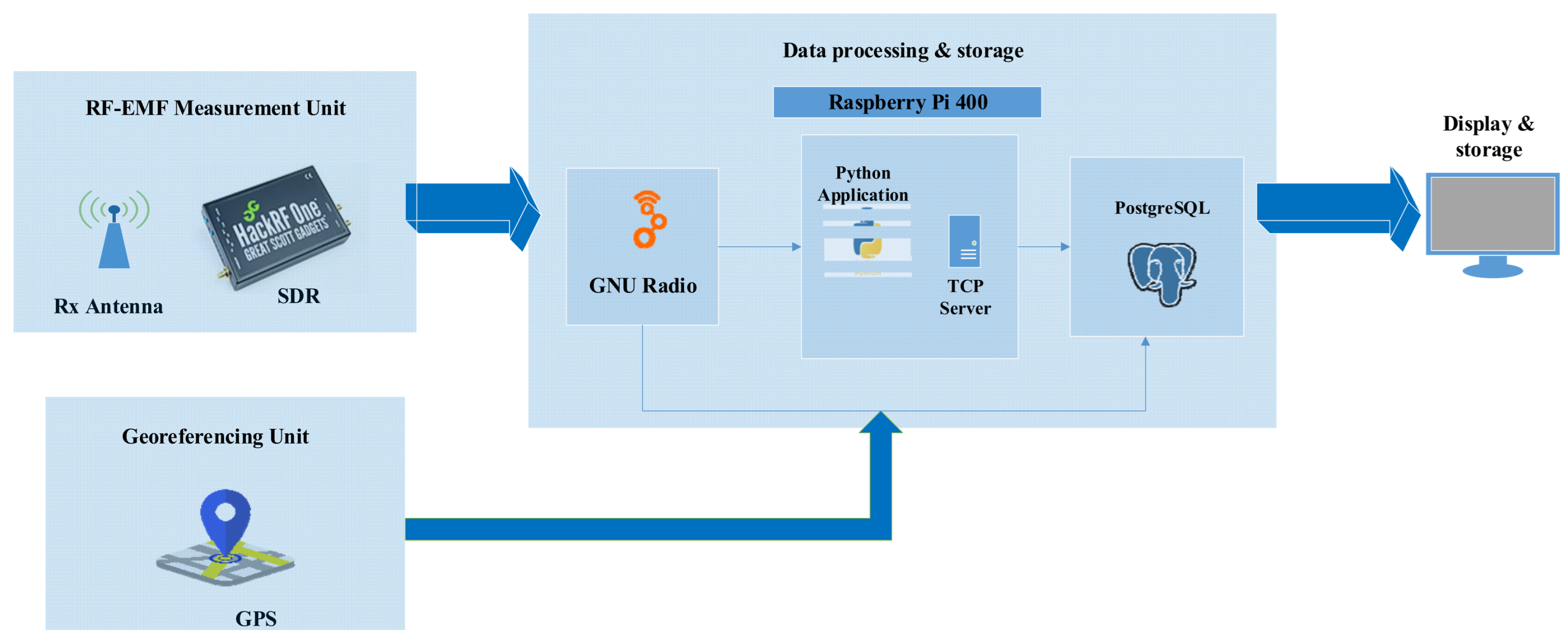
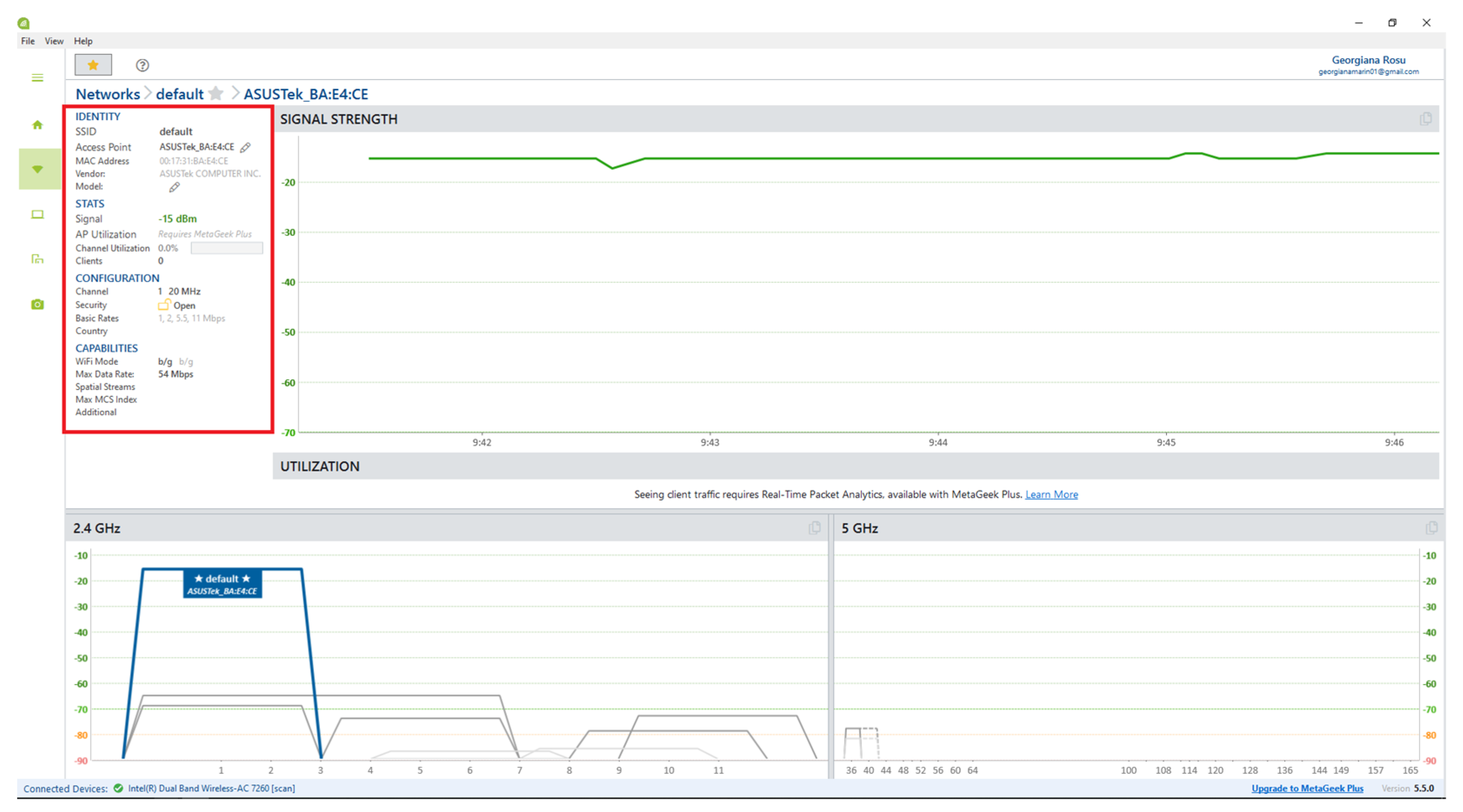

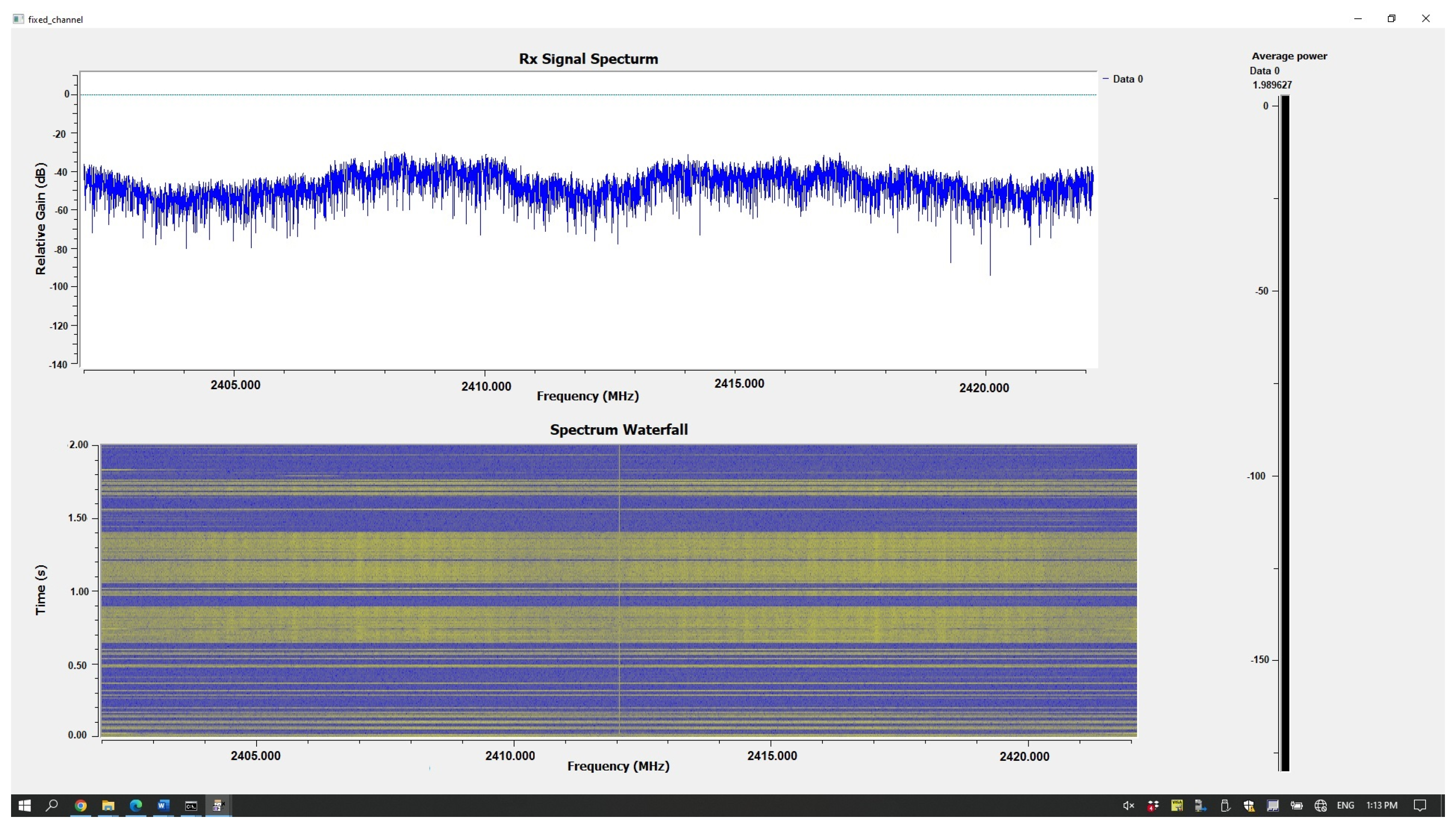
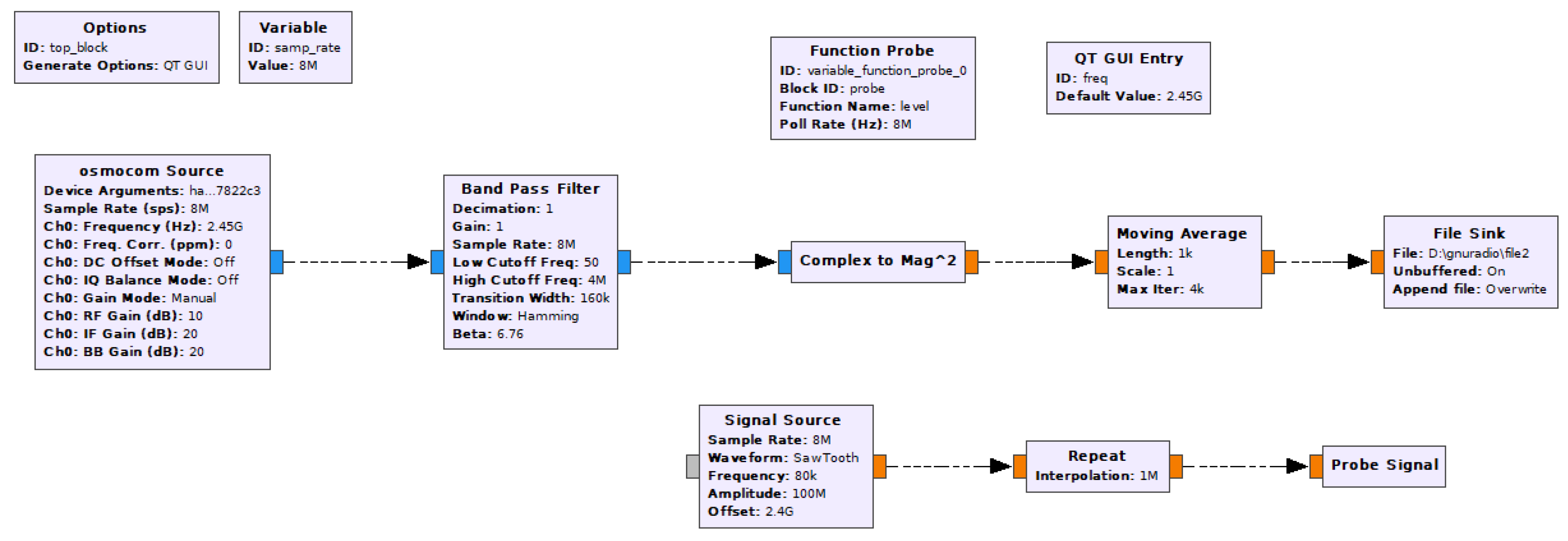

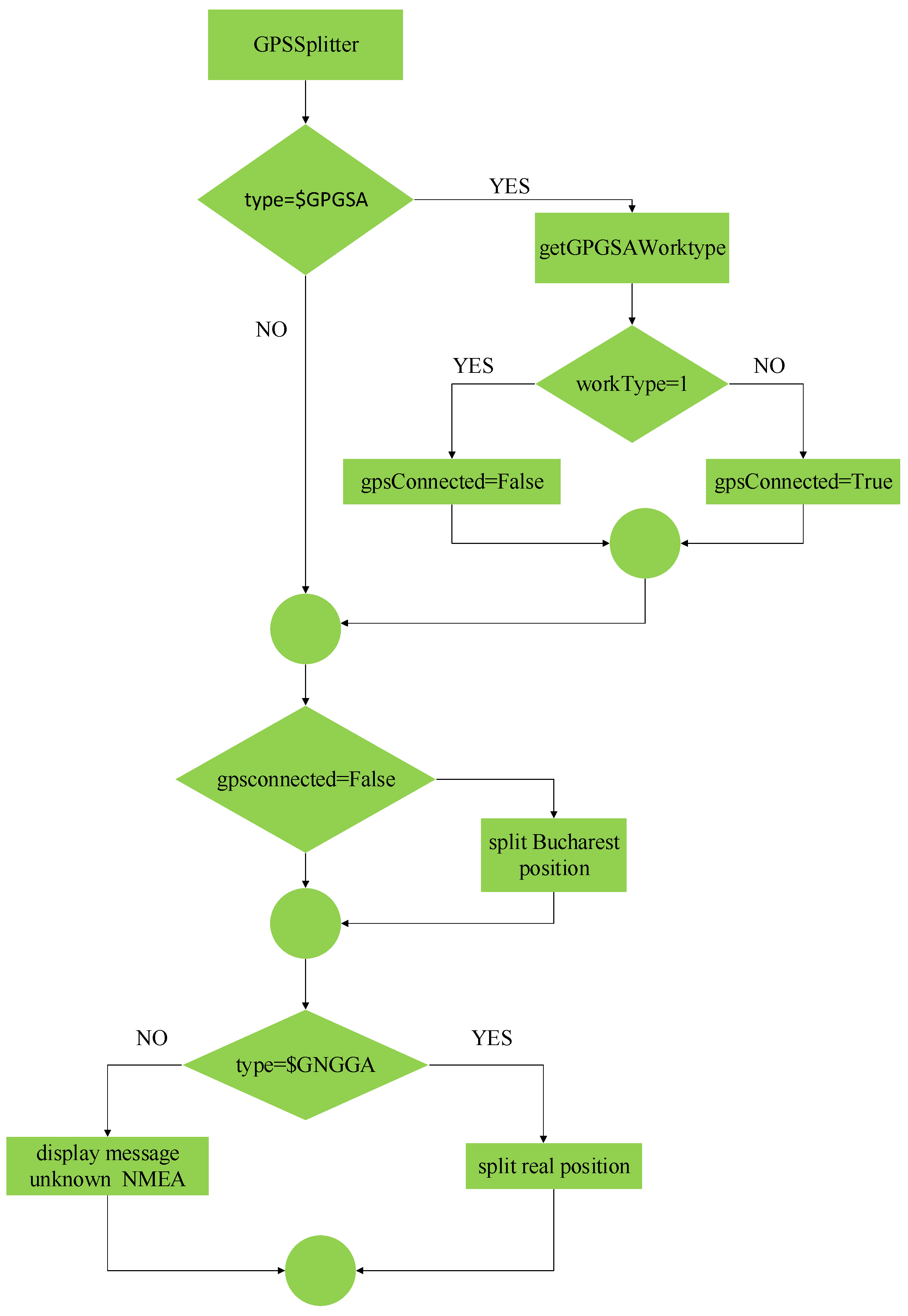



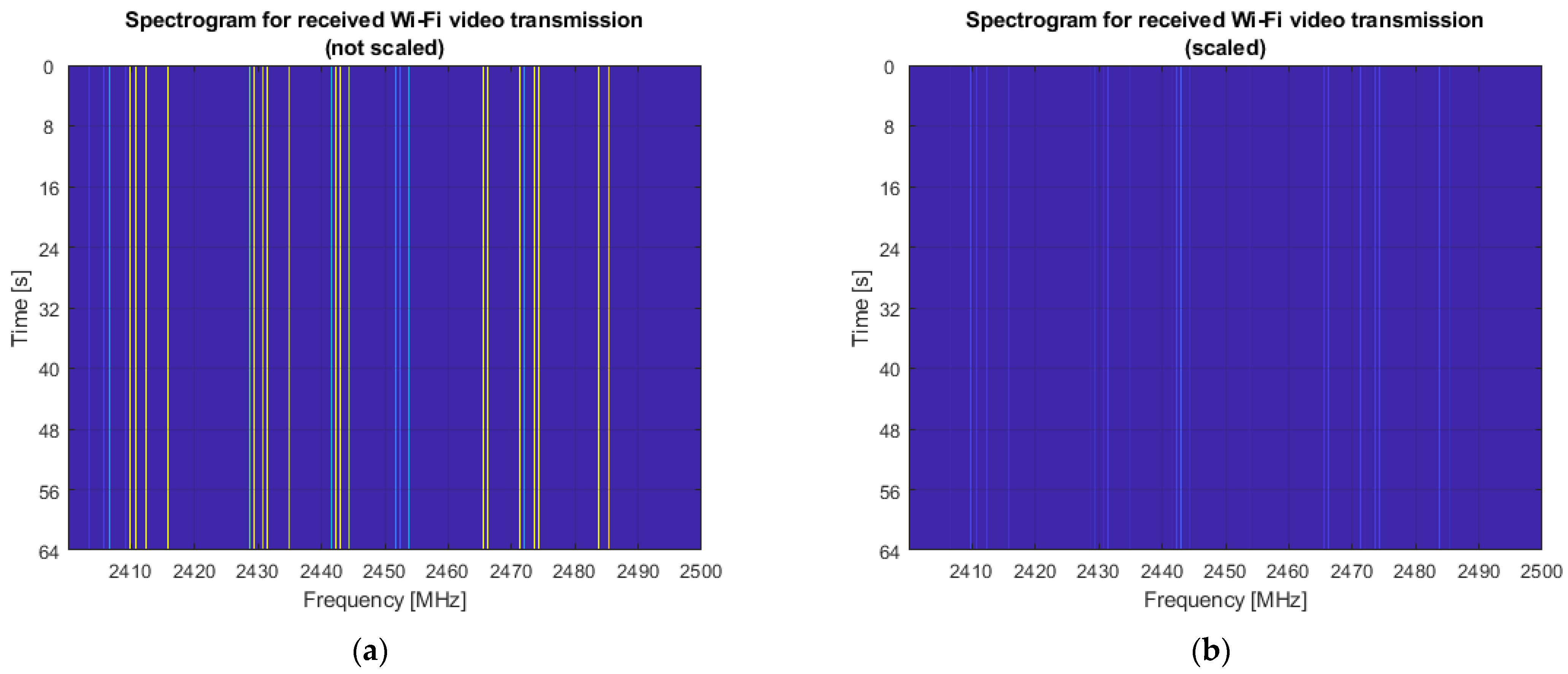
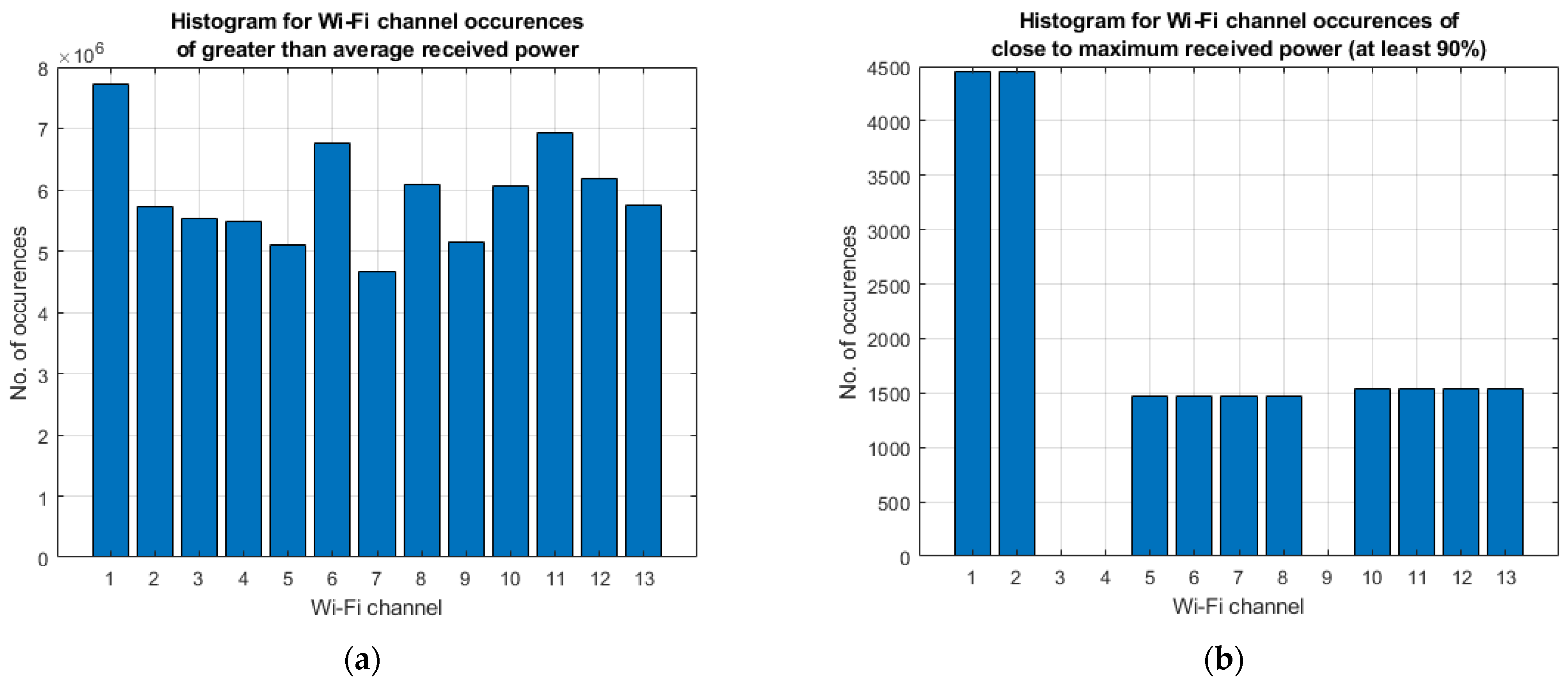

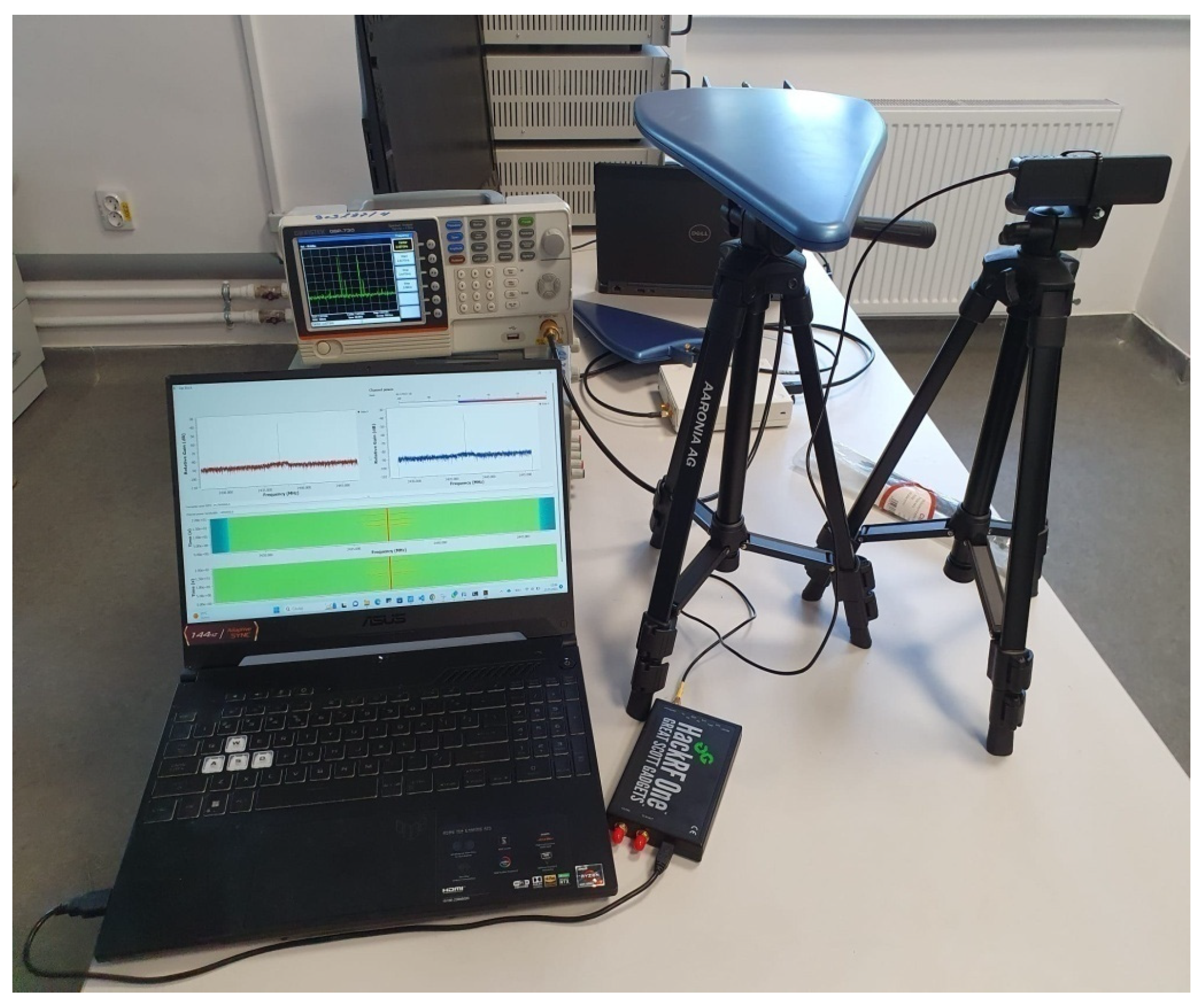
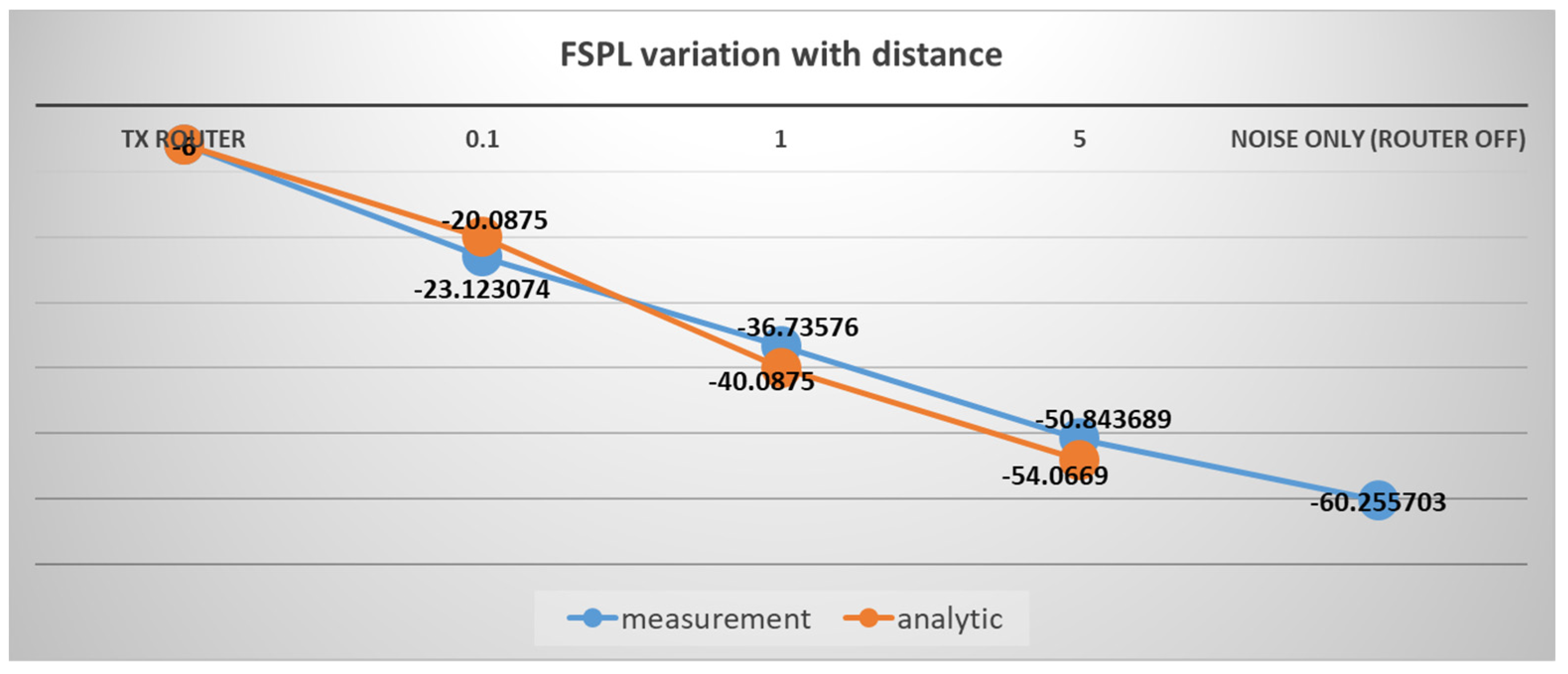
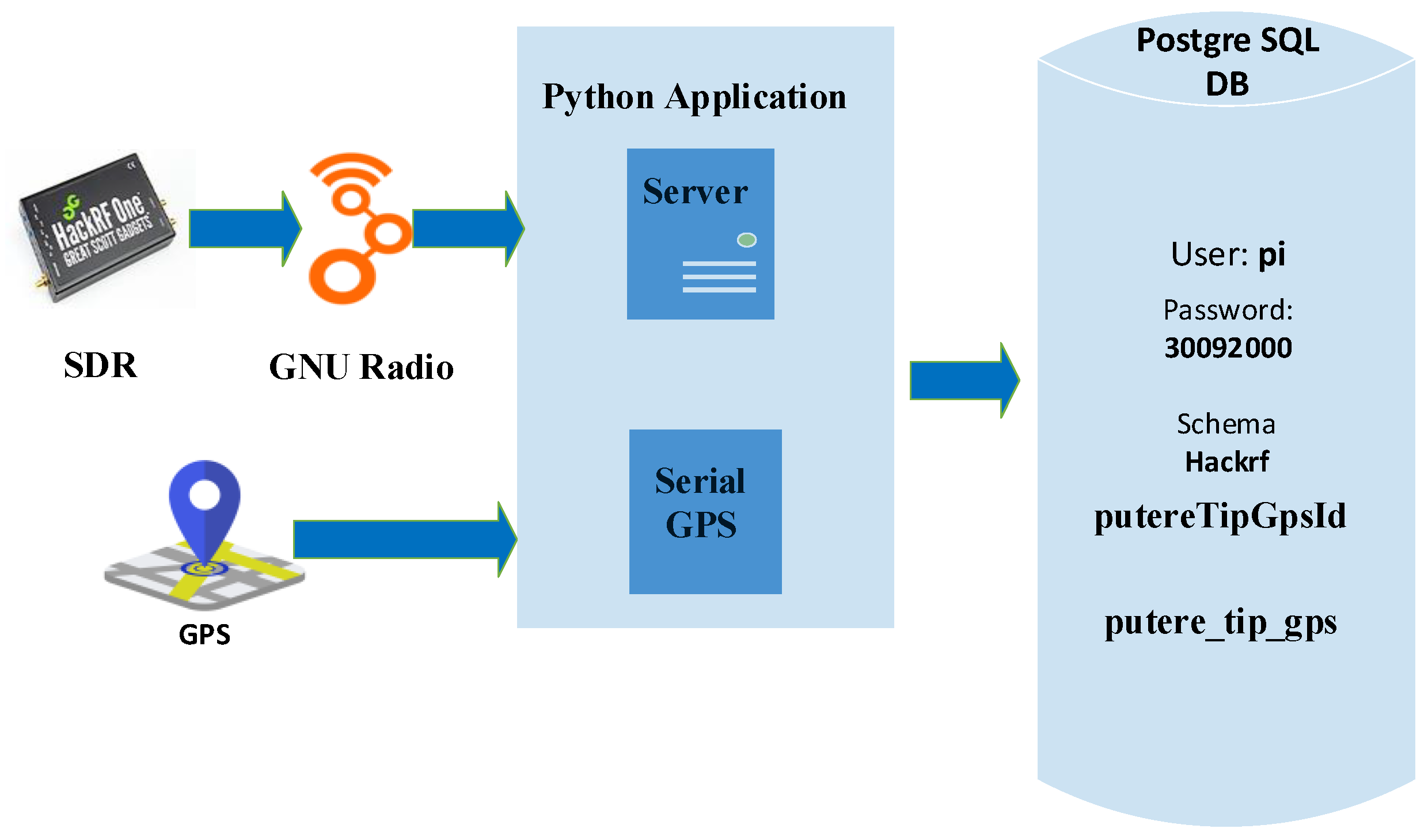


Disclaimer/Publisher’s Note: The statements, opinions and data contained in all publications are solely those of the individual author(s) and contributor(s) and not of MDPI and/or the editor(s). MDPI and/or the editor(s) disclaim responsibility for any injury to people or property resulting from any ideas, methods, instructions or products referred to in the content. |
© 2023 by the authors. Licensee MDPI, Basel, Switzerland. This article is an open access article distributed under the terms and conditions of the Creative Commons Attribution (CC BY) license (https://creativecommons.org/licenses/by/4.0/).
Share and Cite
Tuta, L.; Panait-Radu, F.; Ardelean, F.; Gorgoteanu, D.; Rosu, G. SDR-Based Portable System for Evaluating Exposure to Ambient Electromagnetic Fields. Electronics 2023, 12, 5003. https://doi.org/10.3390/electronics12245003
Tuta L, Panait-Radu F, Ardelean F, Gorgoteanu D, Rosu G. SDR-Based Portable System for Evaluating Exposure to Ambient Electromagnetic Fields. Electronics. 2023; 12(24):5003. https://doi.org/10.3390/electronics12245003
Chicago/Turabian StyleTuta, Leontin, Florentina Panait-Radu, Felix Ardelean, Damian Gorgoteanu, and Georgiana Rosu. 2023. "SDR-Based Portable System for Evaluating Exposure to Ambient Electromagnetic Fields" Electronics 12, no. 24: 5003. https://doi.org/10.3390/electronics12245003
APA StyleTuta, L., Panait-Radu, F., Ardelean, F., Gorgoteanu, D., & Rosu, G. (2023). SDR-Based Portable System for Evaluating Exposure to Ambient Electromagnetic Fields. Electronics, 12(24), 5003. https://doi.org/10.3390/electronics12245003





